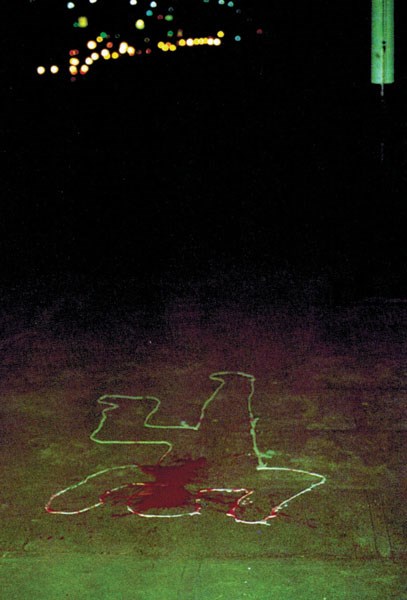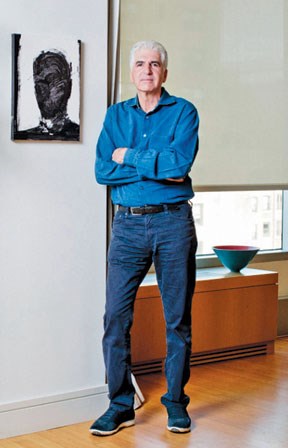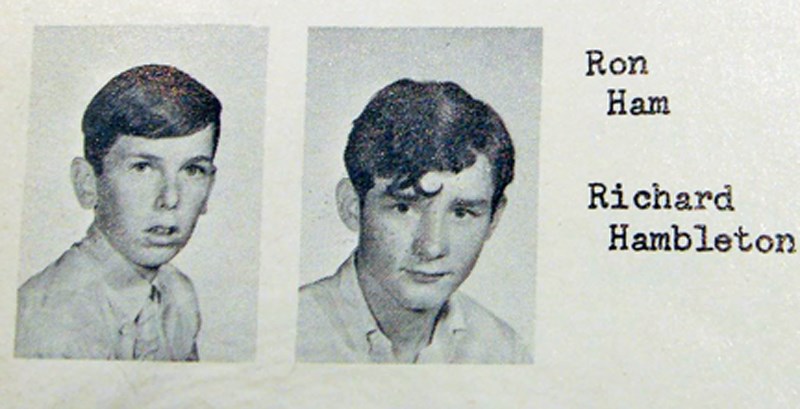Oren Jacoby set out to make a film that he thought he would never finish.
The New York based director produced and directed the 2017 documentary Shadowman, which features the works of the late conceptual artist Richard Hambleton, who grew up in Deep Cove in his family’s home on Mount Seymour Parkway.
During the 1980s in New York, Hambleton was one of the up and coming artists, alongside his conceptual peers Jean-Michel Basquiat and Keith Haring, making a mark in New York’s art scene.
Hambleton was 65 when he died on Oct. 29, 2017. According to the documentary, he painted until his death.
Before he became famous for his mysterious, black shadowy silhouettes that he plastered all over New York City in the late ’80s, Hambleton’s artistic curiosity started at Windsor Secondary.
He was also known in Vancouver’s art scene for his fake crime scene outlines.

Deep Cove resident Christine Elsey said she knew the artist when he went to Windsor in the late ’70s.
“He was interesting,” she said. “But he was really gentle, not very talkative really, but quite expressive at the same time.”
Elsey went to Windsor when she was 16 and was taking the same Grade 11 art class as Hambleton,who was 17. She describes Hambleton at that time as “abstract” and said he had quite a sense of humour.
“He wouldn’t really engage too much,” she said, explaining Hambleton veered toward experimentation, “as opposed to any kind of any structured artistic activity,” she recalled.
“One time in art class he went around the whole class, just experimenting with twisting pieces of string in his fingers in different shapes and going up to people and just showing them what it looked like.”
The film focuses on Hambleton’s early career in New York and chronicles the fame and success he was gaining when he dropped out of the art world.
The rest of the Shadowman centres on Hambleton’s reinstitution into the scene by art dealers Vladimir Restoin Roitfeld and Andy Valmorbida.
Shadowman took Jacoby almost eight years to produce.
“It took forever,” the director said. “I started in 2009 and didn’t really finish it until right before the Tribeca film festival (in March of 2017).”

He explained how the reason was partly the lack of funding and the lack of co-operation by Hambleton. He describes working with the artist as “challenging” at times.
“At certain points he would just become unavailable and we couldn’t do anymore and I sort of gave up the film thinking we’d never get to talk to him,” he said.
“When he was available he could be wonderful and articulate and insightful about his life and his work, but other times we just couldn’t get to him.”
Luckily Jacoby found archival footage and photographs of Hambleton from local artists who knew him in the ’80s.
The film opens up with a black and white shot of Hambleton painting one of his famous shadow silhouettes. Jacoby said getting that footage was a “lucky accident."
“I met somebody at a fancy cocktail party and making sort of chit chat conversations and she told me she had once made a film when she was an art student and I asked her what it was about, and it turned out it was about Richard Hambleton,” he shared.
Asked what Hambleton was like, the words charming, intelligent, funny and ironic flow out of Jacoby’s mouth.
He was introduced to Hambleton in 2009 by his friend Hank O’Neal, who chronically photographed street art in Lower Manhattan for 30 years.
A few of Hambleton’s paintings were featured in O’Neal’s pop-up exhibit in Tribeca.Â
“When I got down there I was shocked that I recognized the artwork that was in Hank’s pictures, which I’ve never seen before,” he explained. “I remembered the work and was sort of excited to rediscover this artist who really knocked me out the first time I’d seen his stuff.”
Jacoby recalls living in Tribeca around the ’80s and seeing the dark shadowy paintings on the walls of Lower Manhattan and being scared because he had no point of reference for Hambleton’s artwork.
“Suddenly there was this figure that I really thought was someone about to jump out of me the first time I saw it and then you stop and realize it wasn’t that, it was a picture,” he said.
The Oscar nominated director was so mesmerized by Hambleton and his artwork that he just started filming without any plan or funding. He dove into the film without having any idea of Hambleton’s past, how complicated his life was, or what his demons were.
“I just began filming and I wasn’t sure how I was going to do it or if anybody would be interested or who would pay for the film but I was just, as I say, mesmerized by Richard and really fell in love with (his) work,” he said.
“I just thought, here’s an exciting possibility to show an artist on his moment of rediscovery."
One of the “demons” that was explored in the film was Hambleton’s drug addiction.
“It was a fundamental part of his life so you couldn’t avoid it,” Jacoby explained. “We tried to focus on his creative career and his artwork. If we do present his addiction in this film the point is to choose him overcoming addiction to be creative and … produce an amazing range of work that he was able to in his career.”
Although the film centres on Hambleton’s life and career, it doesn’t show his past life in Â鶹´«Ă˝Ół»and childhood in Deep Cove. In the beginning of the film Hambleton does say “I’m from Vancouver.”
Due to the lack of funding, Jacoby wasn’t able to fly out to Â鶹´«Ă˝Ół»to delve more into Hambleton’s childhood, which he said he regrets. He also explained how he would try to get Hambleton to talk about his past but the artist would refuse to open up about it.
“I would try to get him to talk about stuff like that, he didn’t seem to really want to engage about that part of his life,” he said.
“I wished many times that I could have gone to Â鶹´«Ă˝Ół»and learned more about his childhood and learned more about his growing up years at the art school and how important that was to him.”

Elsey, who is also from the Cove area, said during the time she knew Hambleton he was experimenting with hallucinogenic drugs, specifically acid.
“He sort of lived for, I think, drugs at that time,” she said. “Almost everybody I knew, around us, was into that but I felt like he was one of the ones really taking it further.”
Jacoby explained how Hambleton used art to deal with his inner demons and that it was a form of therapy for him.
“It was like therapy to confront the things that were haunting him and put them on canvas,” he explained. “He kept on doing it, and kept at it just like all the other hardships that he’d gone through for such a long productive career.”
The film was an official selection at the Tribeca Film Festival and the Â鶹´«Ă˝Ół»International Film Festival.
Shadowman is available online on iTunes and Amazon, Amazon Prime members can watch the film for free. â–


